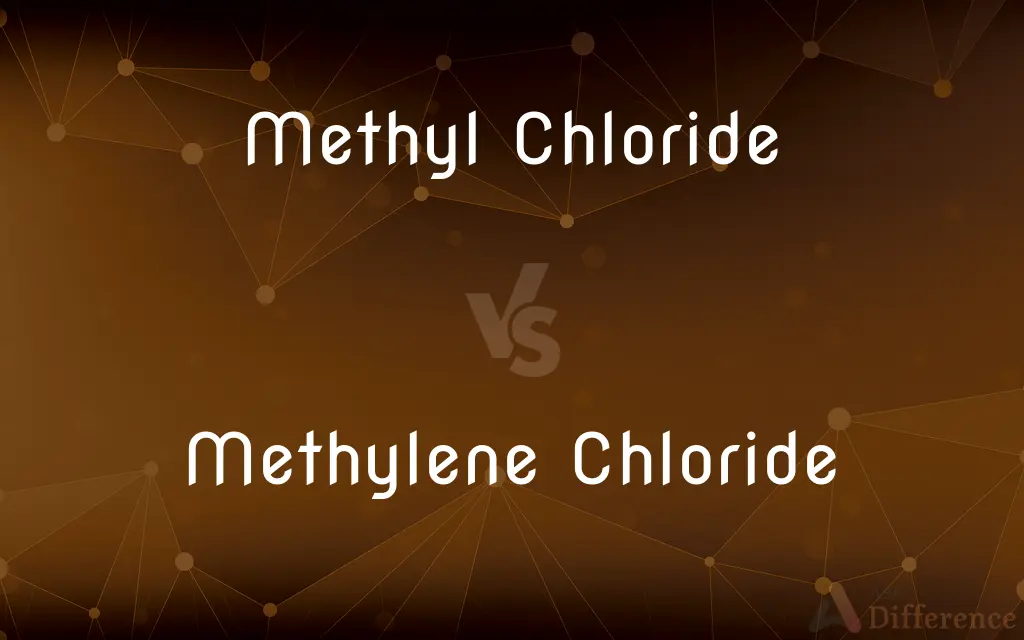Methyl Chloride vs. Methylene Chloride — What's the Difference?
By Fiza Rafique & Urooj Arif — Published on July 12, 2024
Methyl chloride (CH3Cl) is a gas used in refrigeration and as a chemical intermediate, while methylene chloride (CH2Cl2) is a volatile liquid used as a solvent and paint stripper.

Difference Between Methyl Chloride and Methylene Chloride
Table of Contents
ADVERTISEMENT
Key Differences
Methyl chloride, also known as chloromethane, is a colorless, flammable gas at room temperature, primarily used in the production of silicones and as a refrigerant. Methylene chloride, or dichloromethane, is a colorless, volatile liquid with a sweet aroma, widely used as a solvent in paint removers, pharmaceuticals, and the food industry.
Methyl chloride's applications are largely industrial, focusing on chemical synthesis and refrigeration. Methylene chloride's solvent properties make it valuable in various applications, from paint stripping to decaffeination of coffee and tea. Its ability to dissolve a wide range of organic compounds makes it indispensable in laboratories and manufacturing processes.
The toxicity and safety concerns of both chemicals differ significantly. Methyl chloride is highly flammable and toxic, posing risks of neurological effects with long-term exposure. Methylene chloride is also toxic, with risks of cancer and central nervous system effects, but it is not flammable. Its use in consumer products has been increasingly restricted due to health concerns.
Environmental impacts of these chemicals are also a concern. Methyl chloride is a natural and anthropogenic source in the atmosphere, contributing to ozone depletion. Methylene chloride, while less impactful on the ozone layer, poses significant health risks due to its volatility and potential for indoor air pollution.
Both methyl chloride and methylene chloride are chlorinated hydrocarbons used in industrial applications, while their physical states, applications, and safety concerns differ markedly. Their use is regulated to minimize environmental and health risks.
ADVERTISEMENT
Comparison Chart
Physical State
Gas
Liquid
Primary Use
Refrigeration, chemical synthesis
Solvent, paint stripper
Toxicity
Toxic, flammable
Toxic, non-flammable
Environmental Impact
Contributes to ozone depletion
Indoor air pollution risk
Safety Concerns
Neurological effects, flammability
Cancer, central nervous system effects
Compare with Definitions
Methyl Chloride
Methyl chloride is a chlorinated hydrocarbon used as a refrigerant and industrial solvent.
Methyl chloride is used in the manufacture of silicones.
Methylene Chloride
Methylene chloride is used in the pharmaceutical industry as a solvent.
It's involved in the formulation of various drugs.
Methyl Chloride
Exposure to methyl chloride can cause neurological and respiratory issues.
Industrial workers are monitored for methyl chloride exposure levels.
Methylene Chloride
Methylene chloride is a volatile, colorless liquid with a wide range of industrial applications.
Methylene chloride is often used as a paint remover.
Methyl Chloride
It is used in the production of pharmaceuticals and agrochemicals.
Methyl chloride is a feedstock in the synthesis of certain pesticides.
Methylene Chloride
Due to its toxicity, its use in consumer products is restricted.
Safety measures are required when using methylene chloride in enclosed spaces.
Methyl Chloride
It is a colorless, flammable gas with a mild, sweet odor.
Methyl chloride leaks must be handled with caution due to its flammability.
Methylene Chloride
It has a sweet aroma and is used as a solvent in the food industry.
Methylene chloride is employed in the decaffeination process of coffee.
Methyl Chloride
Methyl chloride serves as a chemical intermediate in various organic syntheses.
It's used in the production of butyl rubber.
Methylene Chloride
It poses health risks, including potential carcinogenic effects.
Long-term exposure to methylene chloride vapors is a health concern.
Common Curiosities
What are the safety concerns associated with these chemicals?
Both are toxic: methyl chloride is flammable and can affect the nervous system, while methylene chloride can cause cancer and central nervous system issues.
How do these chemicals impact the environment?
Methyl chloride can contribute to ozone depletion, while methylene chloride poses risks of indoor air pollution.
Are methyl chloride and methylene chloride interchangeable?
No, they have different physical properties and applications.
Why is methylene chloride restricted in consumer products?
Due to its health risks, especially its potential carcinogenic effects.
What are the main uses of methyl chloride and methylene chloride?
Methyl chloride is used in refrigeration and as a chemical intermediate, while methylene chloride is a solvent in paint strippers, pharmaceuticals, and food processing.
Is there a ban on methylene chloride in any countries?
Some countries have banned its use in consumer products due to health risks.
What precautions should be taken when handling these chemicals?
Proper ventilation, use of personal protective equipment, and adherence to safety guidelines are essential.
Can methylene chloride be used in food production?
Yes, it's used in processes like decaffeination of coffee but is tightly regulated due to its toxicity.
How are methyl chloride and methylene chloride produced?
They are produced through various chemical processes, including chlorination of methane for methyl chloride.
Is methyl chloride a natural compound?
Yes, it occurs naturally in the environment but is also produced industrially.
How are workers protected from exposure to these chemicals?
Regulations require protective equipment, ventilation, and exposure monitoring in workplaces.
Can methyl chloride be used in medical applications?
It's primarily used in chemical synthesis, including pharmaceuticals, but not directly in medical treatments.
Can methylene chloride affect indoor air quality?
Yes, its volatility can lead to significant indoor air pollution if not properly managed.
How is exposure to methyl chloride treated?
Treatment focuses on removing the person from exposure, providing fresh air, and seeking medical attention for any symptoms.
Are there alternatives to using methylene chloride as a solvent?
Yes, less toxic solvents are available for many applications, though they may not be as effective for all uses.
Share Your Discovery

Previous Comparison
Cabinet Minister vs. State Minister
Next Comparison
Speaking vs. ThinkingAuthor Spotlight
Written by
Fiza RafiqueFiza Rafique is a skilled content writer at AskDifference.com, where she meticulously refines and enhances written pieces. Drawing from her vast editorial expertise, Fiza ensures clarity, accuracy, and precision in every article. Passionate about language, she continually seeks to elevate the quality of content for readers worldwide.
Co-written by
Urooj ArifUrooj is a skilled content writer at Ask Difference, known for her exceptional ability to simplify complex topics into engaging and informative content. With a passion for research and a flair for clear, concise writing, she consistently delivers articles that resonate with our diverse audience.














































